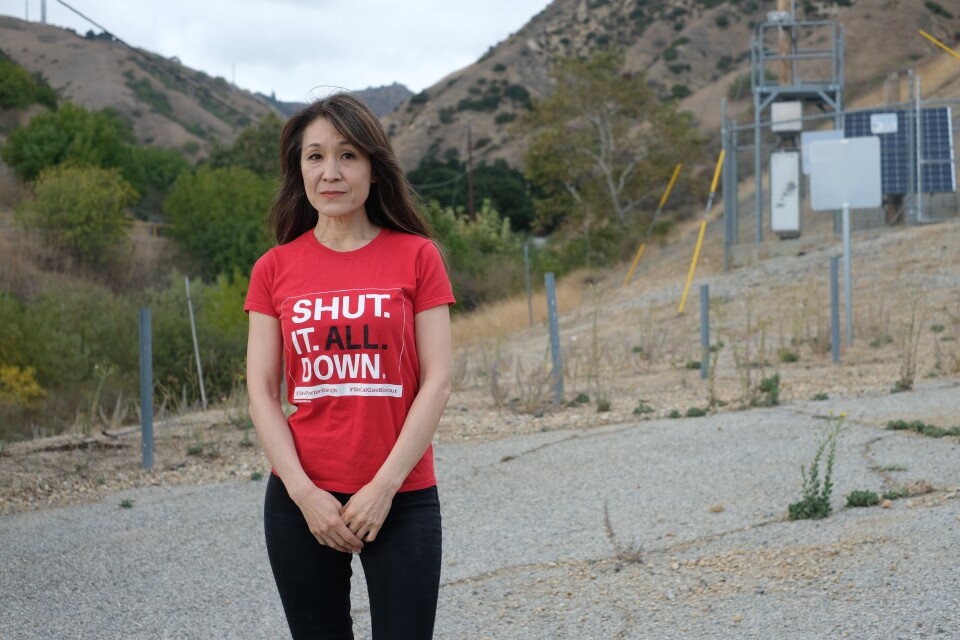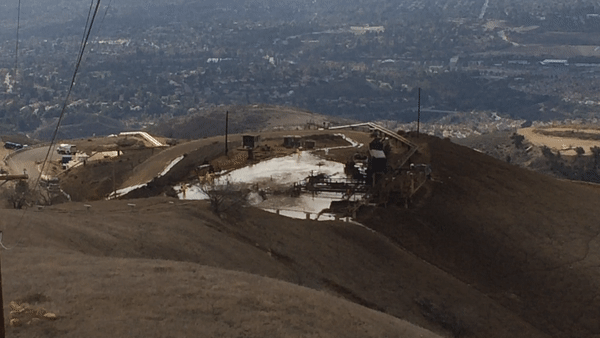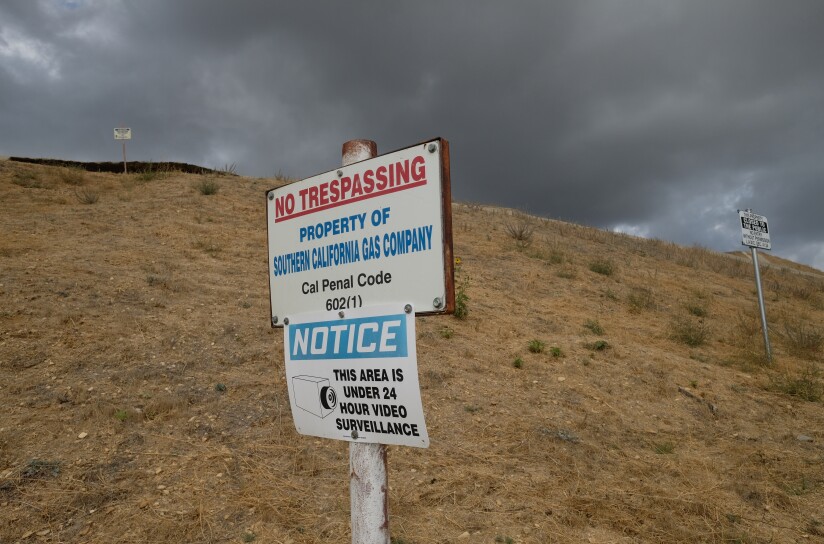Truth matters. Community matters. Your support makes both possible. LAist is one of the few places where news remains independent and free from political and corporate influence. Stand up for truth and for LAist. Make your year-end tax-deductible gift now.
Ten years ago today, what became the largest known gas leak in U.S. history was discovered in the foothills of the Santa Susana Mountains above the San Fernando Valley.
The source — one of the 114 underground wells at Southern California Gas Co.’s Aliso Canyon storage facility, the largest in the state. The leak lasted nearly four months.
Natural gas is primarily composed of methane, a powerful greenhouse gas that heats up the planet far more quickly than carbon dioxide. The leak released a quarter of the entire state’s methane emissions in 2015, equivalent to a year of pollution from half a million cars.

Outdoor air monitoring and sampling inside nearby homes during and after the leak also found elevated levels of carcinogens such as benzene, as well as toxic heavy metals.
As the smell of rotten eggs blanketed parts of the Valley for weeks, thousands of residents in Porter Ranch, Chatsworth and Granada Hills were forced to evacuate. Many reported rashes, nosebleeds, headaches and other strange sicknesses. There were reports of pets unexpectedly dying. Later on, some residents were diagnosed with cancer. Some died. Many think the leak caused it.
Community members organized to push for the facility to be shut down. Former Gov. Jerry Brown (and later, Gov. Gavin Newsom) promised to close it by 2027. SoCal Gas paid out more than $1 billion in settlements and penalties.
Ten years on, a vast quantity of methane continues to be stored at high pressure underground near homes, supplying industry and residences across the region. Lawmakers have passed policies to tighten oversight. Some of the most comprehensive studies on the health effects of natural gas remain underway. Concerns about the facility’s earthquake risk remain.
And for many residents in the nearby neighborhoods, uncertainty and fear remain, too.
They worry about the long-term health effects from the blowout and ongoing pollution. Many maintain a deep mistrust of SoCal Gas and the agencies meant to regulate them.
The blowout continues to force a reckoning over the state’s reliance on natural gas, its energy needs clashing with affordability, as well as the growing understanding of how fossil fuels harm public health and heat up the planet.

Uncertainty about health effects
Kyoko Hibino said she never had serious health issues until she moved to Porter Ranch, a few blocks from the Aliso Canyon storage facility, in 2007.
A few years later, she started coughing and getting nosebleeds. After the 2015 blowout, two of her cats died of cancer. Then, in 2020, Hibino was diagnosed with breast cancer. She’s in remission, but with no family history of cancer, she believes her illness is a result of the blowout and regular exposure to low-level leaks.
Hibino can walk to the facility's gates from her home. Standing there on a recent afternoon took her back to a traumatic time.

“We fight like crazy, and then we got ignored completely. All the memories come when I see this,” she said.
The whole experience led her to co-found the grassroots group Save Porter Ranch. She, alongside neighbors, staged dozens of protests and lobbied lawmakers to shut Aliso down. But she’s mostly lost faith in the system she thought was meant to protect her.
“We go to every single public hearing and [the politicians] say pretty good things, and now it's 10 years later. Nothing changed,” Hibino said.
“I don’t want to be a victim anymore,” she added. “I don’t want to live in fear.”

During and after the 2015 leak, multiple government agencies determined that the chemicals released from the well didn’t exceed standards dangerous to human health over long periods of time.
The South Coast Air Quality Management District, for example, monitored toxins, including benzene, a carcinogen, and hydrogen sulfide. The agency ultimately determined that the elevated levels of these toxins during the leak “are not expected to cause a significant increase in overall risk of health effects from either short-term or long-term exposure.” The levels were similar, AQMD said, to background levels of pollution we all breathe outdoors in Southern California.
“The reality is that natural gas storage at Aliso Canyon is safe and, at current inventory levels, protects California families from utility bill price spikes and provides the electric grid with reliable energy,” a SoCal Gas spokesperson told LAist in a statement.
Support LAist today
Upcoming town hall on the leak anniversary
When: Oct. 26 from 3 to 7 p.m.
Where: The Vineyards at Porter Ranch Community Room
20065 Rinaldi St., Los Angeles
More details here.
But residents dispute that the facility is safe. And ongoing research is showing significant potential health effects.
During and after the leak, the L.A. County Department of Public Health logged thousands of complaints of rashes, headaches, dizziness, nosebleeds, body pain, fatigue and nausea.
Dr. Jeffrey Nordella treated many patients in Porter Ranch.
“People were sick, very sick with different symptoms that did not follow the particular patterns, let's say, of a sinus infection or a gastroenteritis or something along those lines,” Nordella told LAist.
He decided to dig into the reasons himself, obtaining blood sample data from residents across the region and comparing them to those of residents near the leak. He found statistically significant evidence of chronic benzene exposure in Porter Ranch residents. Benzene, a carcinogen, is found in crude oil and may have come from droplets that blew out of the well and landed on homes, cars and playgrounds during the leak.
UCLA researcher Michael Jerrett, who is leading ongoing health studies as part of a settlement agreement, said some of the early analyses by government agencies were limited because they analyzed levels of toxics individually.

“We don't really have a good scientific understanding about what these mixtures do to someone's health,” Jerrett said. “You could have slightly elevated levels of benzene and heavy metals on an ongoing basis, and you'd say, well, if I look at each one of those individually, I don't think there'd be a long-term health threat. But if they have synergisms, they could escalate the potential impact of one contaminant.”
His team's research found benzene and heavy metals inside of homes even after the leak was plugged.
He said it was likely due to the “kill fluids,” or “drilling mud,” used to plug the leak. Several attempts were made, sending plumes of aerosols into the surrounding community.
“When we looked at the contents of what was being used in the mud, many of those metals that we saw elevated in the homes were also in the mud,” Jerrett said.
That prompted a broader study of indoor contaminants by the L.A. County Department of Public Health, which conducted its research several months after the leak was plugged.

That study and subsequent research by Jerrett’s team also found elevated levels of benzene and heavy metals in the air long after the leak was plugged.
“There's some suggestion there that there could be ongoing emissions coming from that facility that are potentially affecting the local community,” Jerrett said.
Research has found that gas storage facilities — and there are hundreds across the nation — are prone to leaking methane, and with methane often comes benzene and other chemicals that are harmful to human health, including potentially for generations to come.
The latest study by Jerrett’s team found that women who were pregnant at the time of the leak had babies with low birth weights at rates almost 50% higher than normal.
Jamie DeRosa of Chatsworth was in the late stages of her pregnancy when the leak started. She had a C-section two weeks before her due date. Her child was born at just 5 pounds, 6 ounces. She feels that she’ll never know if the blowout — the sickening smell that lasted weeks, the oily substance that coated her car, her painful sore throat — contributed to that experience.
Her daughter, now 10, has developed healthily, but DeRosa still worries.
”I try not to think about it because it's something I want to put behind me, and I also definitely don't want to manifest something that's not there yet,” DeRosa said. “But at the same time, it's always in the back of your head.”
What’s changed since the leak?
SoCal Gas said it now conducts regular testing on its wells, has replaced inner steel tubing of every operating well to protect against leaks, and operates the gas storage reservoir at a reduced pressure, as directed by the California Public Utilities Commission and California Geologic Energy Management Division, or CalGEM.
The company also said it now monitors well pressure in real time, conducts visual inspections four times a day, and has installed a fenceline air toxic monitoring system along with methane monitors.
There are also newly installed community air monitors, overseen by the South Coast Air Quality Management District, or AQMD, in nearby parks and neighborhoods that provide near real-time data.
Those changes are largely a result of a slew of policies passed in California since the leak to tighten monitoring of pollution and regulations on such gas storage facilities, which previously had little oversight, said Adam Peltz with the Environmental Defense Fund. The group took the first aerial imagery of the methane plume during the leak that played on TV stations across the nation.
He said the policy changes since 2015 are a step in the right direction.
“Historically, there's been a natural gas storage leak somewhere in the United States around every five years, but there's reason to think that that will get less frequent because, in addition to California adopting good gas storage rules, the federal government adopted its first natural gas storage rules ever in 2017,” Peltz said.
The costs to retrofit and maintain these aging gas storage facilities, and the system as whole, is paid for by ratepayers, Peltz noted.
"How much do we want to spend on these facilities, as opposed to weaning ourselves off fossil fuels “so that we don't need to have these big facilities sitting right next to neighborhoods that, even with risk controls, are still worrisome?” Peltz said.
Who regulates SoCal Gas?
From the federal to the local level, a hodgepodge of agencies have some share in regulating SoCal Gas. The L.A. County Department of Public Health put together this list in the wake of the leak.
Another issue is the “alphabet soup” of agencies in charge of oversight of such facilities, said Mike Gatto, a former state assemblyman who chaired the Assembly’s Utilities and Energy Committee during the Aliso Canyon leak.
“Both the public and regulators themselves benefit from clarity. They benefit from having one clear responsibility, one clear duty, and I'm not sure that the changes post Aliso accomplish that,” Gatto said. “You still have a variety of different agencies that have some share in monitoring the wells and some share in performing the oversight functions that are so critical. That lack of clear authority, I don't think benefits anybody.”
The San Fernando Valley has a wide array of polluting industries — including Aliso Canyon, two big landfills, several recycling centers and more — with a hodgepodge of oversight. Rep. George Whitesides, the Democratic member of Congress who represents much of northern part of the Valley, said he’s pushing for more transparency from and monitoring of such sites at a federal level.
“What we see now is a moment when the administration is trying to decimate EPA [Environmental Protection Agency] funding and other scientific institutions of the federal government,” Whitesides said, “which is going to really harm our ability to both responsibly deal with Aliso, but also the hundreds of other sites across the country that are hurting our citizens today.”
Ongoing pollution
At a park just a few blocks from the entrance to the Aliso Canyon storage facility, a newly installed air monitor sits in the parking lot. Porter Ranch resident Issam Najm gestures toward it.
“ I don't need the monitor to tell me that there are toxic chemicals produced by this facility,” Najm said.

As he sat at a picnic table, he pulled up the numbers on the South Coast Air Quality Management District’s website and listed the emissions that SoCal Gas has reported to the agency since 2017:
- About 2,000 pounds of benzene.
- 29,000 pounds of formaldehyde.
- 1,600 pounds of methanol.
- 1,300 pounds of trichloroethylene.
- 237 tons of volatile organic chemicals, which are major contributors to L.A.’s smog.
“That is SoCal Gas’s own data,” said Najm, an engineering professor who served on the community advisory committee during the leak and as president of the Porter Ranch Neighborhood Council from 2016 to 2020. “There's no need for any additional evidence. There's no change that would make it OK. The only change is that this facility cannot exist in an urban environment.”
Since the 2015 leak, the AQMD has issued 22 violations to SoCal Gas's Aliso facility, mostly involving fugitive methane leaks.
"Aliso Canyon is a large natural gas storage facility, and fugitive emission leaks — though far smaller than what occurred in 2015 — are not unusual," a spokesperson for the agency told LAist.
Najm said the peak of the community’s hope that Aliso would be shut down came in 2019, when Newsom sent a letter to the California Public Utilities Commission urging them to move more quickly to close Aliso’s gates by 2027 or sooner.
In 2022, CPUC officials released a report illustrating pathways to successfully do that. But in 2024, the commission voted to keep the facility open, with analyses on the necessary capacity to be released every two years. The first assessment, released Oct. 1, did find that capacity could be reduced.
“If our representatives really wanted to move on from this facility and remove it from this urban environment, they absolutely had the means and the capabilities to do that,” Najm said. “But it needed courage, and all I can say is that courage was lacking.”
A spokesperson for Newsom told LAist “the governor’s position on Aliso Canyon has not changed — he remains committed to its closure in a way that maintains safe, affordable and reliable energy and protects public health and safety.”
Aliso Canyon provides gas via pipeline to homes, as well as to power plants for generating electricity. Peak use has historically been during winter months, when gas use for heating homes rises.
“The governor wants to see Aliso Canyon phased out, but not at the cost of enormous price spikes for working families and our ability to keep the lights on,” the spokesperson wrote.
Looking to the future
For Najm, his efforts are now focused on making sure the state remembers Aliso as it works on the long-term energy transition. He’s been involved in the latest state-level proceeding on expanding renewable energy sources.
“This is not about we should never use gas,” Najm said. “This is only about the storage volume needed."
Reducing it would mean swapping out gas stoves for induction, gas water heaters and furnaces for heat pumps, and expanding cleaner sources of electricity generation and storage, such as solar, wind and batteries.
Porter Ranch residents will soon be able to purchase heat pumps through a state program. Fines paid by SoCal Gas for the blowout will go towards neighborhood sustainability projects, such as increasing shade at schools in the Valley and upgrading air conditioning systems at community centers.

But for Najm and many survivors, this all feels too incremental. The trauma, and a lack of faith in the system, remains.
“I am far more cynical than I was 10 years ago,” Najm said.
What keeps him going?
“ To be blunt, anger,” Najm said. “I may not be able to do anything at the end of the day, but I'll be damned if I don't try.”












